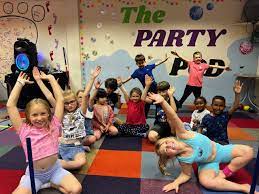
Unleashing the Fun: Exciting Activities for Children to Explore and Enjoy!
Engaging and Exciting Activities for Children: Igniting Creativity and Fun!
Children are like little bundles of energy, always ready to explore, learn, and have fun. As parents and caregivers, it’s important to provide them with activities that not only entertain but also stimulate their growing minds. From indoor adventures to outdoor explorations, here are some fantastic activities that will keep your children engaged and entertained.
- Arts and Crafts: Unleash your child’s creativity with arts and crafts projects. From painting and drawing to collage making and sculpting, these activities allow children to express themselves while developing fine motor skills.
- Outdoor Adventures: Let your children soak up the sunshine by engaging in outdoor activities. Whether it’s playing at the local park, going on nature walks, or having a picnic in the backyard, these experiences promote physical activity, imagination, and appreciation for the environment.
- Storytelling and Reading: Encourage a love for books by reading aloud to your children or creating storytelling sessions where they can let their imaginations soar. This activity not only enhances language skills but also fosters a lifelong passion for reading.
- Science Experiments: Spark curiosity in your child by conducting simple science experiments at home. From making volcanoes erupt with baking soda and vinegar to creating homemade slime, these hands-on activities introduce basic scientific concepts in a fun-filled way.
- Cooking Adventures: Involve your children in the kitchen by letting them assist in simple cooking tasks such as measuring ingredients or decorating cookies. Cooking together not only teaches valuable life skills but also creates lasting memories.
- Music and Dance: Encourage your child’s love for music by introducing them to various musical instruments or dancing along to their favorite tunes. These activities promote coordination, rhythm, self-expression, and can be a great source of joy.
- Sports and Games: Engage your children in team sports or individual games that help develop their physical abilities, coordination, and social skills. Whether it’s football, basketball, or even a game of tag in the garden, these activities promote a healthy lifestyle and teamwork.
- Role-Playing: Encourage your child’s imagination through role-playing activities. Whether they want to be a doctor, astronaut, or superhero for the day, this activity allows them to explore different roles while developing their communication and problem-solving skills.
Remember, the key to successful activities for children is to strike a balance between structure and free play. Allow your child to take the lead in choosing activities that interest them while providing guidance and support when needed.
So go ahead and embark on these exciting adventures with your little ones. Watch as their faces light up with joy and wonder as they engage in these fun-filled activities that foster growth, creativity, and a lifelong love for learning!
8 Frequently Asked Questions about Activities for Children: A Helpful Guide
- What are some age-appropriate activities for my child?
- How can I keep my children entertained during school holidays?
- Are there any free or low-cost activities for children in our area?
- What are some indoor activities to do with children on rainy days?
- How can I encourage my child to be more physically active?
- Are there any educational activities that are also fun for children?
- How do I find local clubs or classes for specific interests, such as art or sports, for my child to join?
- What are some screen-free activities that will engage and entertain my child?
What are some age-appropriate activities for my child?
Choosing age-appropriate activities for your child is essential to ensure their safety, engagement, and developmental growth. Here are some suggestions based on different age groups:
Infants (0-12 months):
– Sensory play: Provide them with toys that stimulate their senses, such as rattles, soft balls, or textured objects.
– Tummy time: Encourage them to strengthen their neck and back muscles by placing them on their tummy with supervision.
– Simple songs and rhymes: Sing lullabies or nursery rhymes to promote language development and bonding.
Toddlers (1-3 years):
– Building blocks: Allow them to explore and build with large blocks or stacking toys.
– Pretend play: Provide dress-up clothes, dolls, or toy kitchen sets to encourage imaginative play.
– Outdoor exploration: Take them to safe playgrounds or parks where they can run, climb, and explore nature.
Preschoolers (3-5 years):
– Arts and crafts: Engage them in drawing, painting, cutting, and pasting activities to enhance creativity and fine motor skills.
– Puzzles and board games: Introduce age-appropriate puzzles or board games that promote problem-solving skills and social interaction.
– Storytelling and reading: Read books together and encourage them to retell stories using their imagination.
School-age children (6-12 years):
– Sports activities: Enroll them in team sports like football, basketball, or swimming to develop physical coordination and teamwork skills.
– Science experiments: Engage in simple science experiments at home that allow them to explore scientific concepts through hands-on learning.
– Music lessons: Encourage them to learn a musical instrument or join a choir to foster creativity and appreciation for music.
Remember that these are general guidelines, and each child develops at their own pace. Observe your child’s interests, abilities, and preferences to tailor activities that suit them best. It’s also important to provide a balance between structured activities and free play, allowing them to explore and discover their own interests.
How can I keep my children entertained during school holidays?
School holidays are the perfect time for children to take a break from their studies and enjoy some well-deserved relaxation and fun. Here are some ideas to keep your children entertained during school holidays:
- Plan Day Trips: Research local attractions such as museums, zoos, parks, or amusement parks that you can visit with your children. These outings provide an opportunity for them to learn, explore, and have a great time.
- Organize Playdates: Arrange playdates with their friends or classmates during the holidays. This will give them a chance to socialize, play games together, and create lasting memories.
- Engage in Creative Activities: Encourage your children’s creativity by providing art supplies for painting, drawing, or crafting. You can also introduce them to DIY projects or science experiments that they can do at home.
- Explore Nature: Take advantage of the good weather by spending time outdoors. Go on nature walks, have picnics in the park, or plan a family hike. Connecting with nature not only provides physical exercise but also helps reduce stress and boost overall well-being.
- Movie Nights: Plan special movie nights at home where you can watch their favorite films together as a family. Make it extra cozy by preparing popcorn and snacks.
- Cook Together: Involve your children in meal preparation by letting them assist in simple cooking tasks such as measuring ingredients or decorating cookies. This activity not only teaches valuable life skills but also creates quality bonding time.
- Read Books: Encourage reading during the holidays by setting aside dedicated reading time each day. Visit the library together and let your children choose books that capture their interest.
- Indoor Games and Puzzles: On rainy days or when staying indoors is preferred, engage your children in board games, puzzles, or card games that challenge their problem-solving skills and promote family interaction.
- Sports and Physical Activities: Encourage your children to stay active by participating in sports or physical activities. This can be as simple as playing catch in the garden, going for a bike ride, or swimming at a local pool.
- Plan a Family Project: Engage in a family project such as building a birdhouse, planting a garden, or creating a scrapbook of holiday memories. This allows everyone to work together towards a common goal and strengthens family bonds.
Remember, school holidays are not just about keeping children entertained but also providing them with opportunities for growth, learning, and quality time with loved ones. So be sure to strike a balance between structured activities and free play, allowing your children to relax and enjoy their time off from school.
Are there any free or low-cost activities for children in our area?
Absolutely! There are often plenty of free or low-cost activities available for children in most areas. Here are a few ideas to explore:
- Local Parks and Playgrounds: Many parks offer free access to playgrounds, sports fields, and walking trails. Take your children for a fun-filled day of outdoor play and exploration.
- Community Events: Keep an eye out for community events such as festivals, fairs, or parades that often include free or affordable activities for children. These events may feature face painting, arts and crafts booths, live performances, and more.
- Public Libraries: Public libraries often organize free storytelling sessions, book clubs, craft workshops, and educational programs for children. Check your local library’s calendar of events to find out what’s on offer.
- Museums and Art Galleries: Some museums and art galleries offer discounted or even free admission for children on specific days or times. Take advantage of these opportunities to expose your child to art, culture, history, and science.
- Nature Centers: Explore local nature centers that provide educational exhibits and guided walks through natural habitats. These centers often have interactive displays that engage children in learning about the environment.
- DIY Craft Projects: Get creative at home with DIY craft projects using materials you already have around the house like paper, cardboard boxes, fabric scraps, or recycled items. Pinterest and other websites offer countless ideas for age-appropriate crafts.
- Community Sports Programs: Look into community sports programs that offer low-cost or subsidized options for children to participate in various sports activities such as soccer, basketball, swimming lessons, or martial arts.
- Local Community Centers: Check if your area has community centers that organize affordable classes or workshops specifically designed for children such as dance lessons, art classes, music lessons, or cooking classes.
Remember to also consider any local organizations or charities that may provide free or low-cost activities during holidays or special occasions. Additionally, keep an eye on local social media groups or community noticeboards for any upcoming events or activities that may be of interest to children.
By exploring these options, you can find a variety of engaging and budget-friendly activities for your children to enjoy in your area.
What are some indoor activities to do with children on rainy days?
Rainy days can be a perfect opportunity for indoor adventures and quality time with your children. Here are some engaging indoor activities to keep them entertained and make the most of those rainy days:
- Board Games: Dust off those board games and have a family game day. Whether it’s classic games like Monopoly or Scrabble, or more interactive ones like Charades or Pictionary, board games encourage critical thinking, problem-solving, and friendly competition.
- Indoor Treasure Hunt: Create an exciting treasure hunt by hiding clues around the house. Let your children follow the clues to discover hidden treasures or surprises at the end. This activity promotes problem-solving skills and keeps them engaged for hours.
- Arts and Crafts: Set up a craft station with various art supplies like paper, markers, crayons, glue, and scissors. Encourage your children to create their own masterpieces or engage in themed crafts such as making paper masks or creating handprint art.
- Indoor Camping: Transform your living room into a cozy campsite by setting up tents, sleeping bags, and blankets. Build a fort using pillows and enjoy indoor camping activities like storytelling with flashlights or having a picnic on the “campground.”
- Movie Marathon: Set up a mini cinema experience at home by watching movies together as a family. Prepare popcorn, snacks, and drinks for that authentic movie theatre feel. Let your children take turns choosing their favorite films or have a themed movie marathon.
- Baking Fun: Get creative in the kitchen by baking delicious treats together. Choose simple recipes like cookies or cupcakes that your children can help prepare and decorate. This activity not only enhances their cooking skills but also provides tasty rewards.
- Science Experiments: Engage in hands-on science experiments using household items. Create homemade volcanoes with baking soda and vinegar, make slime using glue and borax solution (if safe), or conduct simple water experiments to explore the wonders of science.
- Indoor Obstacle Course: Set up an obstacle course using pillows, cushions, and furniture. Challenge your children to complete the course within a specific time or compete against each other. This activity promotes physical activity, coordination, and problem-solving skills.
- Puzzles and Building Blocks: Engage your children’s minds with puzzles or building blocks. Choose age-appropriate puzzles with varying difficulty levels or let them unleash their creativity by building structures with blocks or Lego sets.
- Story Time: Snuggle up together and read books aloud. Encourage your children to choose their favorite stories or introduce them to new ones. Let their imaginations soar as they dive into captivating worlds through the power of storytelling.
Remember, rainy days can be an opportunity for quality bonding time and creativity indoors. Embrace the chance to create lasting memories with your children while keeping them entertained and engaged in fun-filled activities!
How can I encourage my child to be more physically active?
Encouraging your child to be more physically active is a wonderful way to promote their overall health and well-being. Here are some tips to help you inspire your child to get moving:
- Be a Role Model: Children often look up to their parents and caregivers, so lead by example. Engage in regular physical activity yourself, whether it’s going for walks, playing sports, or dancing. When they see you being active and enjoying it, they are more likely to follow suit.
- Make It Fun: Find activities that your child enjoys and make them fun! Incorporate games, challenges, or friendly competitions to keep them engaged. Whether it’s playing catch, jumping rope, or going on a bike ride together, make physical activity an enjoyable experience.
- Limit Screen Time: Set reasonable limits on screen time and encourage your child to spend more time outdoors or participating in active play. Create a balance between sedentary activities and active pursuits.
- Family Activities: Plan family outings that involve physical activity such as hiking, swimming, or playing at the park. This not only encourages exercise but also creates opportunities for quality family bonding.
- Variety is Key: Offer a variety of activities for your child to choose from so they can explore different interests. From team sports to individual activities like martial arts or dance classes, let them find what excites them the most.
- Turn Chores into Physical Tasks: Involve your child in household chores that require physical movement such as gardening, cleaning up the yard, or washing the car. This not only gets them moving but also teaches responsibility and teamwork.
- Encourage Active Playdates: Arrange playdates with other children who enjoy being active. Organize group games like tag or relay races that will keep everyone engaged and having fun.
- Set Goals and Rewards: Help your child set achievable goals for physical activity and reward their efforts when they reach milestones. This can be as simple as a sticker chart or a small treat to acknowledge their progress.
- Be Supportive and Positive: Encourage your child’s efforts and celebrate their achievements, no matter how small. Provide positive reinforcement to boost their confidence and motivation.
- Emphasize the Benefits: Talk to your child about the numerous benefits of being physically active, such as improved strength, coordination, and overall health. Help them understand that exercise is not only good for their body but also for their mind.
Remember, the key is to make physical activity enjoyable and part of your child’s daily routine. By providing opportunities, being supportive, and making it fun, you can inspire your child to embrace an active lifestyle that will benefit them throughout their lives.
Are there any educational activities that are also fun for children?
Absolutely! There are plenty of educational activities that can be both fun and engaging for children. Here are a few examples:
- Science Experiments: Conducting science experiments at home is not only entertaining but also a great way to introduce scientific concepts. From creating homemade volcanoes to exploring the properties of water, these hands-on experiments make learning exciting.
- Puzzle Games: Puzzles, whether jigsaw puzzles or brain teasers, help develop problem-solving skills, improve concentration, and enhance cognitive abilities. They come in various levels of difficulty, making them suitable for different age groups.
- Educational Apps and Games: Many educational apps and games are designed to make learning enjoyable. These interactive tools cover a wide range of subjects like math, language skills, science, and geography while incorporating elements of gameplay.
- Building Blocks and Construction Sets: Playing with building blocks or construction sets not only enhances fine motor skills but also encourages creativity and spatial awareness. Children can build structures, solve design challenges, and even learn about basic engineering principles.
- Nature Exploration: Take your child on nature walks or visits to botanical gardens or zoos. Encourage them to observe plants, animals, and the environment around them. This activity fosters an appreciation for nature while providing opportunities for learning about different species and ecosystems.
- Role-Playing Games: Engaging in role-playing activities allows children to explore different roles while developing their communication and problem-solving skills. Whether it’s pretending to be a chef in a play kitchen or setting up a pretend doctor’s clinic, these activities encourage imagination and creativity.
- Art Appreciation: Introduce your child to the world of art by visiting art galleries or museums that have interactive exhibits designed specifically for children. Let them explore paintings, sculptures, and other artistic creations while encouraging discussions about colors, shapes, emotions, and storytelling.
- Virtual Field Trips: Take advantage of technology by going on virtual field trips to famous landmarks, museums, or historical sites. Many websites offer virtual tours that provide a rich learning experience without leaving the comfort of your home.
Remember, the key to making educational activities fun is to tailor them to your child’s interests and abilities. By incorporating their passions and allowing them to take an active role in their learning, you can create an environment where education becomes an enjoyable adventure!
How do I find local clubs or classes for specific interests, such as art or sports, for my child to join?
Finding local clubs or classes for your child to join is an excellent way to nurture their specific interests and allow them to explore new hobbies. Here are a few steps you can take to find these opportunities:
- Research Online: Start by conducting an online search using keywords related to your child’s interests, along with the name of your city or town. For example, if your child is interested in art classes, search for “art classes for children in [your location].” This should provide you with a list of local options.
- Local Community Centers: Check with community centers, recreation departments, or local libraries in your area. They often offer a variety of classes and clubs for children. Visit their websites or give them a call to inquire about available programs.
- Parenting Groups and Social Media: Join local parenting groups on social media platforms like Facebook or online parenting forums. These communities often share information about local clubs and classes for children. Don’t hesitate to ask for recommendations from other parents who may have already explored such opportunities.
- Schools and Educational Institutions: Reach out to your child’s school or nearby educational institutions like museums, art galleries, or sports centers. They may offer after-school programs or be able to recommend external organizations that provide classes related to your child’s interests.
- Local Sports Associations: If your child is interested in sports, look for local sports associations or teams dedicated to specific sports in your area. They often have websites or contact information where you can inquire about joining opportunities.
- Word of Mouth: Talk to other parents, neighbors, friends, and family members who may have knowledge of clubs or classes suitable for your child’s interests. Personal recommendations can be valuable in finding reputable organizations.
- Local Events and Fairs: Attend community events, fairs, or exhibitions that focus on children’s activities and hobbies. These events often showcase various clubs and classes available locally.
Once you have a list of potential clubs or classes, take the time to research each one. Look into their reputation, teaching methods, safety measures, and any reviews or testimonials from other parents. It’s also a good idea to visit the location if possible or speak directly with the instructors to get a better sense of the program.
Remember, every child is unique, so it’s important to involve your child in the decision-making process. Consider their preferences and interests when selecting a club or class. By providing them with opportunities to pursue their passions, you’re helping them grow and develop in areas they truly enjoy!
What are some screen-free activities that will engage and entertain my child?
In a world dominated by screens, it’s important to provide children with screen-free activities that promote creativity, imagination, and healthy development. Here are some engaging and entertaining screen-free activities for your child:
- Outdoor Adventures: Encourage your child to explore the great outdoors. Whether it’s going for a nature walk, playing at the park, or having a scavenger hunt in the backyard, outdoor activities stimulate their senses and foster a connection with nature.
- Arts and Crafts: Engage your child’s creativity through arts and crafts projects. Provide them with materials like paints, crayons, paper, glue, and scissors to create masterpieces. They can draw, paint, collage or even make DIY crafts using recyclable materials.
- Board Games and Puzzles: Gather the family for some good old-fashioned board game fun. Choose age-appropriate games that promote problem-solving skills, strategic thinking, and social interaction. Puzzles are also great for cognitive development and critical thinking.
- Reading and Storytelling: Encourage a love for books by reading aloud to your child or creating storytelling sessions where they can let their imaginations run wild. This activity not only enhances language skills but also sparks their creativity.
- Building Blocks and Construction Sets: Let your child unleash their inner architect or engineer with building blocks or construction sets like LEGO. These toys help develop fine motor skills, spatial awareness, problem-solving abilities, and encourage imaginative play.
- Cooking and Baking: Involve your child in simple cooking tasks like measuring ingredients or decorating cookies. This activity teaches valuable life skills while providing an opportunity for quality bonding time.
- Science Experiments: Conduct simple science experiments at home using household items. From making a volcano erupt to creating slime or growing plants from seeds – these hands-on activities spark curiosity while teaching basic scientific principles.
- Music and Dance: Encourage your child’s love for music by introducing them to musical instruments or having dance parties. They can sing, dance, or even create their own musical compositions. This activity promotes self-expression and boosts their confidence.
- Role-Playing and Pretend Play: Encourage imaginative play by providing costumes, props, and a designated play area. Let your child explore different roles and scenarios, which helps develop communication skills, empathy, and creativity.
- Nature Crafts: Collect leaves, rocks, or flowers during outdoor adventures and use them to create nature-inspired crafts like leaf rubbings or rock painting. This activity connects children with the natural world while encouraging creativity.
Remember, the key is to provide a balance of structured activities and free playtime for your child’s overall development. By engaging in these screen-free activities, you’ll not only entertain your child but also foster their growth, curiosity, and imagination in a healthy way.



